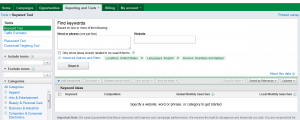The Many Faces Of Negative Keywords
Many advertisers who may be unfamiliar with all of the positive effects that come as a result of negative keywords tend to shy away from implementing negative keywords within their account altogether; other advertisers may sporadically add negative keywords to their account, but not take enough advantage of just how much a little manipulation of these keywords can boost an account’s performance.
Regardless of Clicks, Get Rid of Those Irrelevant Searches


First and foremost, negative keyword “audits” should be performed on a regular basis, regardless of your industry, your results, or your budget. Discovering negative keywords is easy, and adding negative keywords is even easier. While some advertisers may not see the harm in appearing for irrelevant searches every so often, it is essential to recognize the negative effects this will have on your account in both the long and short term. The obvious is wasted spend – no one wants to waste clicks and money on visitors who were searching for something completely different than your ad is offering. Often I find myself answering the following question, however: “So what if my ad shows up, but no one clicks it? No money wasted, no harm done, right?” Wrong. It is an absolute must that any advertisers understand the harm that irrelevant ads can have on an account even when they are not clicked. Click-through rate is the largest (but not only) determinant of quality score, and your quality score is a large (but not only) determinant of your CPCs; therefore, negative keywords help us maintain a strong click-through rate, resulting in higher quality scores, and therefore lower CPCs (and more money to spend on the clicks that will convert!)
Negative Keywords Don’t Just “Block” Searches

The key element of adding this match type throughout the campaigns and ad groups in your account is not only ensuring your ads aren’t showing up for irrelevant searches, but also ensuring that the best and most relevant ad available in your account is triggered over another. Many people ignore this use of the negative match type, and focus solely on excluding irrelevant searches, when in reality one of the best uses of this match type is the ability to manipulate your account with makeshift “filters,” which are useful for virtually every advertiser.
Let’s say you have a generic campaigns set up for Vacuums, containing the broad match term “bagless vacuums,” while you have another campaign set up for specific vacuum brands containing the broad match keyword “bagless ABC vacuums.” Although these keywords are not identical, it is possible for either one of them to be triggered by the search “bagless ABC vacuums.” While many advertisers do not see any harm in a generic ad showing up for the search term “bagless ABC vacuums,” it is essential that you ensure a relevant ad containing the brand ABC is shown, vs. a generic one. This is where negative keywords come into play, filtering the keywords in our account to ensure the best ad is triggered. It’s simple – make sure the negative keyword “ABC” is added throughout all generic campaigns, ensuring that generic ads won’t be triggered by this branded search. Repeat this process through all of your campaigns, using the same rules to exclude generic search queries from triggering brand-specific ads and to set filters for the various vacuum-type keywords and ads. While this can be a lengthy process, it will pay off with higher click-through rates, higher quality scores, and lower CPCs. Don’t be afraid to add negative keywords on a regular basis, or fear that you’re limiting your traffic – remember the traffic that matters is traffic that’s relevant, no exceptions.


